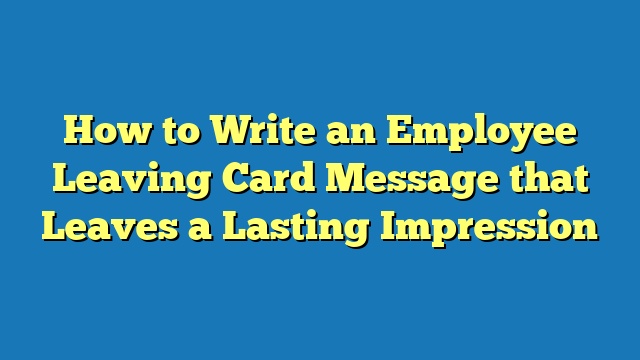An employee leaving card message is a written message that is given to an employee who is leaving their job. It is typically written by the employee’s manager or colleagues, and it expresses appreciation for the employee’s work and wishes them well in their future endeavors. For example, “We want to thank you for your dedication and hard work over the past five years. We wish you all the best in your new role.”
Employee leaving card messages are a simple but effective way to show appreciation for an employee who is leaving. They can help to boost morale and create a positive work environment. Historically, employee leaving card messages were often handwritten, but today they are often sent electronically.
This article will explore the importance of employee leaving card messages, the benefits of sending them, and some key historical developments. We will also provide some tips for writing a great employee leaving card message.
Employee Leaving Card Message
Employee leaving card messages are an important part of the employee leaving process. They provide an opportunity for colleagues and managers to express their appreciation for the employee’s work and to wish them well in their future endeavors. Key aspects of employee leaving card messages include:
- Appreciation: Expressing gratitude for the employee’s contributions.
- Well wishes: Offering support and encouragement for the employee’s future.
- Recognition: Acknowledging the employee’s accomplishments and impact.
- Sincerity: Writing a message that is genuine and heartfelt.
- Personalization: Tailoring the message to the individual employee.
- Professionalism: Maintaining a respectful and appropriate tone.
- Timeliness: Sending the message promptly after the employee’s departure.
- Presentation: Choosing a visually appealing and appropriate card.
- Confidentiality: Respecting the employee’s privacy.
These aspects are important because they help to create a positive and supportive work environment. They also show the employee that they are valued and appreciated. When writing an employee leaving card message, it is important to keep these aspects in mind. By doing so, you can create a message that is meaningful and memorable.
Appreciation
Appreciation is a key component of an employee leaving card message. It is important to express gratitude for the employee’s contributions to the team and the company. This shows the employee that they are valued and appreciated. When employees feel appreciated, they are more likely to be engaged and productive. They are also more likely to stay with the company.
There are many ways to express appreciation in an employee leaving card message. You can thank the employee for their specific contributions, such as their hard work, dedication, or creativity. You can also express your appreciation for their personal qualities, such as their positive attitude or their willingness to help others. Whatever you say, make sure it is sincere and heartfelt.
Here are some examples of how to express appreciation in an employee leaving card message:
- “Thank you for your hard work and dedication over the past five years. You have been a valuable member of our team and we will miss you.”
- “We appreciate your creativity and innovative ideas. You have helped us to develop new products and services that have made a difference in our customers’ lives.”
- “Thank you for your positive attitude and your willingness to help others. You have made our workplace a more enjoyable place to be.”
By expressing appreciation in an employee leaving card message, you can show the employee that they are valued and appreciated. This can help to create a positive and supportive work environment, and it can also encourage employees to stay with the company.
Well wishes
When an employee is leaving, it is important to offer them support and encouragement for their future. This can be done through a well-written employee leaving card message. Well wishes can help the employee to feel appreciated and valued, and they can also provide them with the motivation to succeed in their new endeavors.
- Expression of confidence: Expressing confidence in the employee’s abilities and potential. Example: “We know that you have a bright future ahead of you.”
- Offer of support: Offering to help the employee in any way possible. Example: “Please don’t hesitate to reach out to us if you need anything.”
- Encouragement: Encouraging the employee to pursue their dreams and goals. Example: “We believe in you and your ability to achieve great things.”
- Best wishes: Wishing the employee all the best in their future endeavors. Example: “We wish you all the best in your new role.”
Offering support and encouragement to an employee who is leaving can help to create a positive and supportive work environment. It can also help to build strong relationships between employees and their colleagues. When employees feel supported and valued, they are more likely to be engaged and productive. They are also more likely to stay with the company.
Recognition
Recognition is a critical component of an employee leaving card message. It is important to acknowledge the employee’s accomplishments and impact on the team and the company. This shows the employee that they are valued and appreciated, and it can also motivate them to continue to achieve great things in their future endeavors.
There are many ways to recognize an employee’s accomplishments and impact in an employee leaving card message. You can thank the employee for their specific contributions, such as their hard work, dedication, or creativity. You can also express your appreciation for their personal qualities, such as their positive attitude or their willingness to help others. Whatever you say, make sure it is sincere and heartfelt.
Here are some examples of how to recognize an employee’s accomplishments and impact in an employee leaving card message:
- “Thank you for your hard work and dedication over the past five years. You have been a valuable member of our team and we will miss you.”
- “We appreciate your creativity and innovative ideas. You have helped us to develop new products and services that have made a difference in our customers’ lives.”
- “Thank you for your positive attitude and your willingness to help others. You have made our workplace a more enjoyable place to be.”
- “We are grateful for your contributions to the team. You have helped us to achieve our goals and we wish you all the best in your future endeavors.”
By recognizing an employee’s accomplishments and impact in an employee leaving card message, you can show the employee that they are valued and appreciated. This can help to create a positive and supportive work environment, and it can also motivate employees to continue to achieve great things.
Sincerity
Sincerity is a key aspect of writing an employee leaving card message. A genuine and heartfelt message will show the employee that you care about them and appreciate their contributions. It will also make the message more meaningful and memorable.
- Be yourself: Don’t try to be someone you’re not. Write in your own voice and express your own feelings.
- Speak from the heart: Write what you truly feel about the employee. Don’t just say what you think they want to hear.
- Be specific: Don’t just say “Thank you for your hard work.” Instead, be specific about what you’re grateful for.
- Be personal: Share a personal anecdote or memory that you have of the employee. This will make the message more meaningful and memorable.
By following these tips, you can write an employee leaving card message that is sincere, heartfelt, and meaningful. This will show the employee that you care about them and appreciate their contributions.
Personalization
Personalization is a critical component of an employee leaving card message. A personalized message shows the employee that you care about them and that you appreciate their unique contributions to the team. It also makes the message more meaningful and memorable.
There are many ways to personalize an employee leaving card message. You can mention the employee’s specific accomplishments, thank them for their unique skills and talents, or share a personal anecdote or memory. Whatever you choose to say, make sure it is sincere and heartfelt.
Here are some examples of personalized employee leaving card messages:
- “Thank you for your hard work and dedication over the past five years. You have been a valuable member of our team and we will miss you.”
- “We appreciate your creativity and innovative ideas. You have helped us to develop new products and services that have made a difference in our customers’ lives.”
- “Thank you for your positive attitude and your willingness to help others. You have made our workplace a more enjoyable place to be.”
- “We are grateful for your contributions to the team. You have helped us to achieve our goals and we wish you all the best in your future endeavors.”
By taking the time to personalize your employee leaving card message, you can show the employee that you care about them and that you appreciate their contributions. This will help to create a positive and supportive work environment, and it can also motivate employees to continue to achieve great things.
Professionalism
Professionalism is a critical component of an employee leaving card message. A respectful and appropriate tone shows the employee that you care about them and that you value their contributions. It also makes the message more meaningful and memorable.
There are many ways to maintain a professional tone in an employee leaving card message. First, avoid using slang or informal language. Second, be respectful of the employee’s decision to leave. Third, focus on the positive aspects of the employee’s time with the company. Finally, proofread your message carefully before sending it.
Here are some examples of professional employee leaving card messages:
- “Thank you for your hard work and dedication over the past five years. We wish you all the best in your future endeavors.”
- “We are grateful for your contributions to the team. You have helped us to achieve our goals and we wish you all the best in your future endeavors.”
- “We have enjoyed working with you and we will miss you. We wish you all the best in your new role.”
By following these tips, you can write an employee leaving card message that is professional, respectful, and meaningful. This will show the employee that you care about them and that you appreciate their contributions.
Timeliness
Timeliness is an important aspect of employee leaving card messages. Sending the message promptly after the employee’s departure shows that you care about them and that you appreciate their contributions. It also helps to create a positive and supportive work environment.
- Expresses appreciation: Sending a timely message shows the employee that you appreciate their work and that you value them as a colleague.
- Provides support: A timely message can provide the employee with support and encouragement as they transition to a new job.
- Creates a positive work environment: Sending timely messages to departing employees helps to create a positive and supportive work environment. It shows that the company cares about its employees and that it values their contributions.
- Avoids awkwardness: Sending a timely message can help to avoid awkwardness or uncomfortable situations. If you wait too long to send a message, the employee may feel forgotten or unappreciated.
In general, it is best to send an employee leaving card message within a week of the employee’s departure. This gives the employee time to receive and appreciate the message, but it is also soon enough that the message is still relevant and meaningful.
Presentation
The presentation of an employee leaving card message is an important part of the overall message. A visually appealing and appropriate card can help to convey the sender’s sincere appreciation and well wishes for the departing employee. Conversely, a poorly chosen or executed card can undermine the message and make it seem insincere or impersonal.
There are a few key things to consider when choosing a card for an employee leaving card message. First, consider the employee’s personality and interests. If the employee is known for their sense of humor, a funny or lighthearted card may be appropriate. If the employee is more serious, a more formal or elegant card may be more suitable.
Second, consider the occasion. If the employee is leaving for a new job, a card that wishes them well in their new role would be appropriate. If the employee is retiring, a card that expresses gratitude for their years of service would be more suitable. Finally, consider the sender’s relationship with the employee. If the sender is a close friend or colleague, a more personal card may be appropriate. If the sender is a supervisor or manager, a more formal card may be more suitable.
By taking the time to choose a visually appealing and appropriate card, the sender can create a lasting impression on the departing employee. A well-chosen card can show the employee that they are valued and appreciated, and it can help to create a positive and supportive work environment.
Confidentiality
Confidentiality is an essential aspect of employee leaving card messages. Respecting the employee’s privacy means protecting their personal information and avoiding sharing any sensitive or confidential information in the message. This includes information such as their salary, performance reviews, or medical history.
- Employee’s personal information: This includes the employee’s name, address, phone number, and email address. It is important to only include this information if the employee has given you permission to do so.
- Performance reviews: Performance reviews contain sensitive information about the employee’s work performance. This information should not be shared in an employee leaving card message without the employee’s consent.
- Medical history: Medical history is confidential information that should not be shared without the employee’s consent. This includes information about the employee’s physical or mental health.
- Other sensitive information: Any other information that could be considered sensitive or confidential should not be shared in an employee leaving card message without the employee’s consent.
Respecting the employee’s privacy is important for maintaining a positive and professional relationship with the employee. It also helps to protect the employee’s reputation and privacy.
FAQs on Employee Leaving Card Messages
This section provides answers to frequently asked questions about employee leaving card messages. These questions address common concerns and misconceptions, ensuring a comprehensive understanding of the topic.
Question 1: What is the purpose of an employee leaving card message?
An employee leaving card message is a written expression of appreciation and well wishes given to an employee who is leaving their job. It serves to acknowledge the employee’s contributions, express gratitude, and wish them success in their future endeavors.
Question 2: Who should write an employee leaving card message?
Typically, employee leaving card messages are written by the employee’s manager, colleagues, or team members. However, anyone who has worked closely with the departing employee can contribute a message.
Question 3: What should be included in an employee leaving card message?
An effective employee leaving card message should include expressions of appreciation for the employee’s hard work and dedication, well wishes for their future success, and recognition of their positive impact on the team.
Question 4: What should be avoided in an employee leaving card message?
Avoid using generic or impersonal language, negative or critical comments, or overly personal or sensitive information. Maintain a professional and respectful tone throughout the message.
Question 5: When should an employee leaving card message be sent?
Employee leaving card messages should be sent promptly after the employee’s departure, ideally within a week. This shows that the employee is valued and appreciated.
Question 6: Can electronic employee leaving card messages be used?
Yes, electronic employee leaving card messages are acceptable, provided they are professional and respectful. However, handwritten messages may add a personal touch and convey a greater sense of sincerity.
These FAQs provide a comprehensive overview of employee leaving card messages, addressing common questions and concerns. They emphasize the importance of expressing appreciation, maintaining professionalism, and respecting the employee’s privacy. By following these guidelines, organizations can create meaningful and impactful employee leaving card messages that foster positive relationships and create a supportive work environment.
In the next section, we will explore the benefits of sending employee leaving card messages and discuss best practices for creating effective messages.
Tips for Writing Effective Employee Leaving Card Messages
To ensure your employee leaving card messages are meaningful and impactful, follow these practical tips:
Tip 1: Be Sincere and Personalize: Craft a heartfelt message that reflects the employee’s unique contributions and qualities.
Tip 2: Express Appreciation and Gratitude: Acknowledge the employee’s hard work, dedication, and positive impact on the team.
Tip 3: Offer Well Wishes and Support: Express your genuine well wishes for their future endeavors and offer support if needed.
Tip 4: Maintain a Professional Tone: Use appropriate language and avoid overly casual or emotional expressions.
Tip 5: Proofread Carefully: Ensure your message is free of errors and conveys a positive and respectful tone.
Tip 6: Choose a Suitable Card: Select a card that reflects the employee’s personality and the occasion.
Tip 7: Send Promptly: Convey your appreciation timely, ideally within a week of the employee’s departure.
Tip 8: Respect Employee Privacy: Avoid sharing sensitive or confidential information in the message.
By following these tips, you can create impactful employee leaving card messages that acknowledge the employee’s contributions, express sincere well wishes, and maintain a professional and respectful tone.
In the concluding section, we will delve into the benefits of sending employee leaving card messages and their role in fostering a positive work environment.
Conclusion
Employee leaving card messages are a valuable tool for expressing appreciation, fostering a positive work environment, and maintaining professional relationships. By acknowledging the contributions of departing employees and offering well wishes for their future endeavors, organizations can create a culture of respect and support.
Key points highlighted in this article include:
- Employee leaving card messages serve as a tangible expression of gratitude and appreciation.
- They provide an opportunity for colleagues and managers to recognize the employee’s impact and wish them well.
- Effective employee leaving card messages are sincere, personalized, and respectful, contributing to a positive and supportive work environment.
In conclusion, employee leaving card messages are not mere formalities but meaningful gestures that foster a culture of appreciation and respect in the workplace. They strengthen relationships, create lasting impressions, and contribute to the overall well-being of the organization.









Tips for Using "Template by Kevin Crafts" Comments for Meaningful Online Discussions